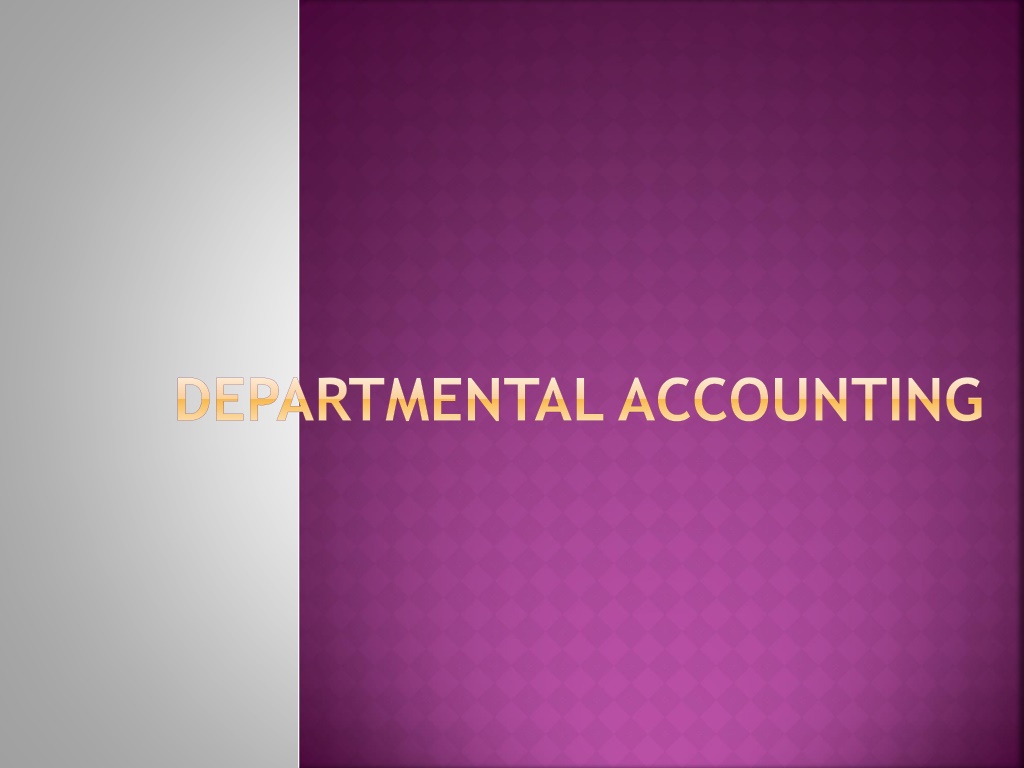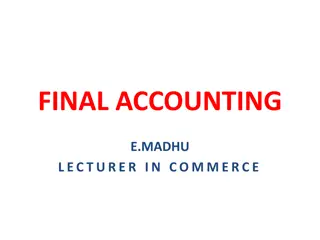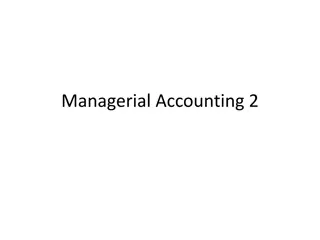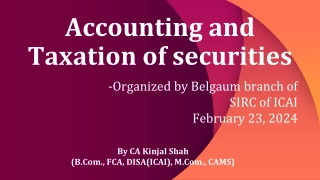Understanding Departmental Accounting in Business Organizations
Departmental accounting involves analyzing and recording financial information by department to evaluate performance, efficiency, and growth potential. It helps in allocating expenses, preparing income statements, and identifying successful managers. The advantages include performance evaluation, growth assessment, and facilitating planning and control. Various methods and techniques are used to manage departmental accounts effectively.
Download Presentation
Please find below an Image/Link to download the presentation.
The content on the website is provided AS IS for your information and personal use only. It may not be sold, licensed, or shared on other websites without obtaining consent from the author. Download presentation by click this link. If you encounter any issues during the download, it is possible that the publisher has removed the file from their server.
- Departmental Accounting
- Financial Management
- Business Organization
- Expense Allocation
- Performance Evaluation
Presentation Transcript
LEARNING OBJECTIVES Identify the advantages of keeping departmental records Allocate direct expenses and apportion common (indirect) expenses associated with departments Prepare departmental income statements (trading, profit and loss account) 2
WHAT IS DEPARTMENTAL ACCOUNTING? A method of accounting , which is designed to ascertain the trading and operational results of each department of a departmental business organization. The process of providing accounting information analysed by departments, so that each department of an organization can be treated as a separate unit . 3
ADVANTAGES OF DEPARTMENTAL ACCOUNTING Evaluation of performance Evaluation of growth potential Provides justification for capital outlay Evaluation of efficiency Facilitates planning and control Helps in creating competitive environment Helps in identifying successful managers 4
METHODS AND TECHNIQUES OF DEPARTMENTAL ACCOUNTS Separate sets of books for each department. To keep accounting records of departments analytically, but its very expensive. Single set of books for all departments kept in a columnar/tabular form. Subsidiary books such as sales and purchases are also prepared in a columnar form to show records for each department. 5
ALLOCATION AND APPORTIONMENT OF EXPENSES Expenses which are related to a particular/specific department Charged to that particular department. E.g. salary paid to foreman in production department, may be charged directly to the production department. Expenses which relate to two or more departments Apportion to the departments concerned on some suitable/equitable basis. E.g. rent of the shop can be apportioned according to the floor area occupied by each department. Expenses which cannot be allocated/apportioned reasonably Directly recorded in the combined Income Statement. E.g. bank interest, audit fees etc. 6
COMMON BASIS OF APPORTIONMENT Income/Expenses Basis of Apportionment Sales of each department Salesmen salary, salesmen Commission, Selling expenses, Discount allowed, Advertisement, Bad debts, Carriage outward, Provision for bad debts, Showroom rent etc. Discount received, Carriage inward Rents and rates, Insurance on building, air conditioning expenses, Repairs and maintenance of building Canteen expenses, Labour welfare expenses, Medical expenses Depreciation of assets, repair and maintenance of assets, Insurance on asset Lighting Power Purchases of each department Floor area of each department Number of employees of each department Asset value of each department Light points, Number of lights Horse Power 7
FORMAT OF DEPARTMENTAL INCOME STATEMENT Dept. A xx (xx) xx Dept. B xx (xx) xx Total xxx (xxx) xxx Sales Returns Inward Net Sales (A) Cost of Goods Sold Opening stock Purchases Carriage Inwards xx xx xx xx (xx) xx (xx) xx xx xx xx xx xx (xx) xx (xx) xx xx xxx xxx xxx xxx (xxx) xxx (xxx) xxx xxx Return Outwards Goods available for sale Closing stock (B) Gross Profit (A-B) 8
FORMAT OF DEPARTMENTAL INCOME STATEMENT Dept. A Dept. B Total Gross Profit b/d xx xx xxx Other Income xx xx xxx Total Income xx xx xxx Expenses (xx) (xx) (xxx) Net Profit xx xx xxx NB: This format is used when preparing the income statement on gross profit basis 9
TYPES OF DEPARTMENTS Independent departments Have negligible inter department transfers Dependent departments Have transfer of goods from one department to another for further processing Issues may arise as a result of the transfer price (at cost/selling price) 10
INTER-DEPARTMENTAL TRANSFERS Goods and services could be transferred from one department to the other on one of the following basis: Cost Market price Cost plus a percentage of profit 11
UNREALIZED PROFIT Transfers made at cost price are credited to the supplying department and debited to the receiving department. Further adjustments not needed Transfers made at cost plus profit/market price Provides a possibility of unrealized profit when part of the goods transferred remain unsold Any unrealized profit arising from transfer of goods and services should be eliminated in the final accounts. 12

















































